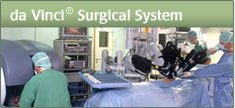About da Vinci® Surgery
Myomectomy Surgery
Learn about fibroid removal surgery (myomectomy) and understand your options
Move freely through life
Uterine fibroids are benign (noncancerous) growths generally found inside the uterus or its walls. While fibroids may cause no symptoms, some women experience moderate to severe symptoms that disrupt their lives in significant ways, including pelvic pain, heavy menstrual bleeding, infertility, and miscarriages.
Fibroids are often diagnosed during a routine pelvic exam. To learn more about the size and location of the fibroid tumors, your doctor may have you undergo other tests, such as ultrasonography which uses soundwaves to create images. Doctors can use this information to discuss the best option with you.1
Understanding your optionsDepending on the severity of your fibroid symptoms, your doctor may recommend a wait-and-see strategy or prescribe medications to shrink fibroids. Other options to shrink fibroids include using heat or cold to destroy the fibroids or cutting off blood supply to the fibroids (embolization).1, 2 If symptoms are affecting your quality of life, your doctor may recommend hysterectomy surgery to remove your fibroids and uterus. Myomectomy surgery is another option that removes the fibroids while leaving the uterus intact, so that you may still be able to have children. However, because the uterus remains, there is a chance new fibroids could grow in the future.1 Your surgeon can perform fibroid removal through open surgery or by using a minimally invasive approach. In traditional open surgery, which requires a large incision (cut) in your abdomen and through the uterus wall, the surgeon looks directly at the uterus through the incision and removes the fibroids with handheld tools. There are three minimally invasive approaches to uterine fibroid removal. A vaginal (hysteroscopic) myomectomy is performed through the vagina using a long, lighted scope and a fibroid-removal instrument. While vaginal myomectomy requires no incisions, your surgeon will have to determine if the location and size of your fibroids allow for this approach. The other minimally invasive approaches are laparoscopic and robotic-assisted surgery (possibly with da Vinci technology). Both are performed through a few small incisions. In laparoscopic surgery, surgeons use special long-handled tools while viewing magnified images from the laparoscope (camera) on a video screen. |
 |
How the da Vinci system worksSurgeons can perform myomectomies using da Vinci technology. During robotic-assisted fibroid removal surgery with a da Vinci system, your surgeon sits at a console next to you and operates using tiny, fully wristed instruments. A camera provides a high-definition, 3D magnified view inside your body. Every hand movement your surgeon makes is translated by the da Vinci system in real time to bend and rotate the instruments with precision. |
It’s important to remember that Intuitive does not provide medical advice. After discussing all options with your doctor, only you and your doctor can determine whether surgery with a da Vinci system is appropriate for your situation. You should always ask your surgeon about his or her training, experience, and patient outcomes.
What are the outcomes of surgery with the da Vinci system?
Be sure to talk with your surgeon about the surgical outcomes he or she delivers by using the da Vinci system, as every surgeon's experience is different. For example, ask about:
- Length of hospital stay
- Complication rate
- Rate of returning to the hospital within 30 days of surgery
- Reoperation rate
- Transfusion and/or blood loss
- Chance of changing to an open procedure
- Length of operation
- Mortality rate
There are additional outcomes of surgery that you may want to talk with your doctor about. Please ask him or her about all important outcomes of surgery. All surgery involves risk. You can read more about associated risks of myomectomy surgery here.
Questions you can ask your doctor
- What options are available to address my uterine fibroids? Which is best for my situation?
- What are the differences between open, vaginal, laparoscopic, and robotic-assisted surgery?
- Should I get a second opinion?
- What am I likely to experience after surgery?
- If I decide to have surgery, how can I prepare for it?
- Can you tell me about your training and experience using the da Vinci system?
- How will I feel after surgery?
Resources for learning more
Myomectomy surgery brochureRead this brochure to help enable a meaningful and informed conversation with your doctor about different options. |
Gynecologic surgery with the da Vinci systemGynecology surgeons use robotic-assisted surgery with da Vinci technology in many different types of procedures. |
1. Uterine Fibroids. Frequently Asked Questions: Gynecologic Problems. The American College of Obstetricians and Gynecologists. Web. 14 May 2020
2. Health Topics: Uterine Fibroids. Office on Women’s Health. U.S Department of Health & Human Services. Web. 14 May 2020
Disclosures and Important Safety Information
Surgical Risks
Risks associated with myomectomy (removal of fibroid tumors) include tear or hole in uterus, split or bursting of the uterus, pre-term (early) birth, spontaneous abortion. Uterine tissue may contain unsuspected cancer. The cutting or morcellation of uterine or fibroid tissue during surgery may spread cancer, and decrease the long-term survival of patients.
Important Safety Information
Patients should talk to their doctor to decide if da Vinci surgery is right for them. Patients and doctors should review all available information on non-surgical and surgical options and associated risks in order to make an informed decision.
Serious complications may occur in any surgery, including da Vinci surgery, up to and including death. Serious risks include, but are not limited to, injury to tissues and organs and conversion to other surgical techniques which could result in a longer operative time, and/or increased complications. For Important Safety Information, including surgical risks, indications, and considerations and contraindications for use, please also refer to www.intuitive.com/safety.
Individuals' outcomes may depend on a number of factors, including but not limited to patient characteristics, disease characteristics and/or surgeon experience.
Da Vinci Xi System Precaution Statement
The demonstration of safety and effectiveness for the specific procedure(s) discussed in this material was based on evaluation of the device as a surgical tool and did not include evaluation of outcomes related to the treatment of cancer (overall survival, disease-free survival, local recurrence), or treatment of the patient’s underlying disease/condition. Device usage in all surgical procedures should be guided by the clinical judgment of an adequately trained surgeon.
Medical Advice and Locating a Doctor
Patients should talk to their doctor to decide if da Vinci surgery is right for them. Other options may be available and appropriate. Only a doctor can determine whether da Vinci surgery is appropriate for a patient’s situation. Patients and doctors should review all available information on both non-surgical and surgical options in order to make an informed decision.
Surgeons who utilize the da Vinci system can be found using the Surgeon Locator. Intuitive Surgical only provides surgeons with training on the use of the da Vinci system but does not certify, credential, or qualify the surgeons listed in the Surgeon Locator.
Product names are trademarks or registered trademarks of Intuitive Surgical or their respective owners. See www.intuitive.com/trademarks.
![]() Powered by Encounter CSS ™ | Terms of Use
Powered by Encounter CSS ™ | Terms of Use
In This Section

da Vinci overcomes limitations of both traditional and minimally invasive surgery. [ click here ]

View our comprehensive online library of health care topics. [ click here ]

